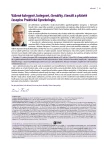Women’s experience of abortion
Authors:
Petra Kramná; Yvetta Vrublová
Authors‘ workplace:
Gynekologicko-porodnická klinika LF OU a FN Ostrava
Published in:
Prakt Gyn 2016; 20(2): 101-106
Category:
Gynecology and Obstetrics
Overview
Goal:
The purpose of the paper was to describe the experience of women who had undergone a termination of pregnancy for genetic reasons in the second trimester of pregnancy.
Design:
qualitative phenomenological study.
Method:
the cohort comprised 10 females who had undergone genetically indicated termination of pregnancy in the second trimester of pregnancy. The data was collected by means of a semi-structured interview.
Results:
3 categories and 9 subcategories were created based on data analysis: 1. The time before termination (a shock and loss of hope, making a decision without having the “right choice”), 2. termination procedure (doing what is necessary and putting it quickly behind oneself, need of information, need of support), 3. the time following end of pregnancy (experiencing loss, parting, getting back to everyday life, another pregnancy).
Conclusion:
Termination of pregnancy for genetic reasons is one of the most difficult situations that a woman can go through. Sufficient information, empathic approach and psychological support are important for women not only during the medical procedure but also in the following period.
Key words:
genetically indication – psychological support – termination of pregnancy
Sources
1. Bryar SH. One day you’re pregnant and one day you’re not: pregnancy interruption for fetal anomalies. J Obstet Gynecol Neonatal Nurs 1997; 26(5): 559–566.
2. Burgoine GA, Van Kirk SD, Romm J et al. Comparison of perinatal grief after dilation and evacuation or labor induction in second trimester terminations for fetal anomalies. Am J Obstet Gynecol 2005; 192(2): 1928–1932.
3. Ferreira da Costa L, Hardy E, Duarte Osis MJ et al. Termination of pregnancy for fetal abnormality incompatible with life: women’s experiences in Brazil. Reprod Health Matters 2005; 13(26): 139–146.
4. Zákon České národní rady o umělém přerušení těhotenství. In: Sbírka zákonů Československé socialistické republiky 66/1986, částka 22. Dostupné z WWW: <http://www.epravo.cz/_dataPublic/sbirky/archiv/sb22–86.pdf>.
5. Vyhláška Ministerstva zdravotnictví Československé socialistické republiky, kterou se provádí zákon České národní rady č. 66/1986 Sb., o umělém přerušení těhotenství. In. Sbírka zákonů Československé socialistické republiky. 75/1986, částka 24. Dostupné z WWW: <http://www.epravo.cz/_dataPublic/sbirky/archiv/sb24–86.pdf>.
6. Davies V, Gledhill J, McFadyen A et al. Psychological outcome in women undergoing termination of pregnancy for ultrasound-detected fetal anomaly in the first and second trimesters: a pilot study. Ultrasound Obstet Gynecol 2005; 25(4): 389–392.
7. Gawron LM, Cameron KA, Phisuthikul A et al. An exploration of women’s reasons for termination timing in the setting of fetal abnormalities. Contraception 2013; 88(1): 109–115.
8. Hern WM. Fetal diagnostic indications for second and third trimester outpatient pregnancy termination. Prenat Diagn 2014; 34(5): 438–444.
9. Hendl J. Kvalitativní výzkum. Portál: Praha 2005. ISBN 80–7367–040–2.
10. Hunt K, France E, Ziebland S et al. ‘My brain couldn’t move from planning a birth to planning a funeral’: a qualitative study of parents’ experiences of decisions after ending a pregnancy for fetal abnormality. Int J Nurs Stud 2009; 46(8): 1111–1121.
11. Keefe-Cooperman K. A comparison of grief as related to miscarriage and termination for fetal abnormality. OMEGA 2004–2005, 50(4): 281–300.
12. Kersting A, Kroker K, Steinhard J et al. Psychological impact on women after second and third trimester termination of pregnancy due to fetal anomalies versus women after preterm birth--a 14-month follow up study. Arch Womens Ment Health 2009; 12(4): 193–201.
13. Korenromp MJ. Parental adaptation to termination of pregnancy for fetal anomalies. University Utrecht: Utrecht (Netherlands) 2006. ISBN-10: 90–9020734–1.
14. Korenromp MJ, Page-Christiaens GC, van den Bout J et al. A prospective study on parental coping 4 months after termination of pregnancy for fetal anomalies. Prenat Diagn 2007; 27(8): 709–716.
15. Korenromp MJ, Page-Christiaens GC, van den Bout J et al. Adjustment to termination of pregnancy for fetal anomaly: a longitudinal study in women at 4, 8, and 16 months. Am J Obstet Gynecol 2009; 201(2): 160.e1–160.e7. Dostupné z DOI: <http://dx.doi.org/10.1016/j.ajog.2009.04.007>.
16. Lafarge C, Mitchell K, Fox P. Termination of pregnancy for fetal abnormality: a meta-ethnography of women’s experiences. Reprod Health Matters 2014; 22(44): 191–201.
17. Maguire M, Light A, Kuppermann M et al. Grief after second-trimester termination for fetal anomaly: a qualitative study. Contraception 2015; 91(3): 234–239.
18. [Royal College of Obstetricians and Gynaecologists]. Termination of Pregnancy forFetal Abnormality in England, Scotland and Wales. Report of a working party May 2010. RCOG: London 2010. Dostupné z WWW: <https://www.rcog.org.uk/globalassets/documents/guidelines/terminationpregnancyreport18may2010.pdf>.
19. Salvesen KA, Oyen L, Schmidt N et al. Comparison of long-term psychological responses of women after pregnancy termination due to fetal anomalies and after perinatal loss. Ultrasound Obstet Gynecol 1997; 9(2): 80–85.
20. Steinberg JR. Later abortions and mental health: psychological experiences of women having later abortions--a critical review of research. Womens Health Issues 2011; 21(3 Suppl): S44-S48.
21. Vial Y, Tran C, Addor MC et al. Screening for foetal malformations: performance of routine ultrasonography in the population of the Swiss Canton of Vaud. Swiss Med Wkly 2001; 131(33–34): 490–494.
22. Wojnar DM, Swanson KM. Phenomenology: an exploration. J Holist Nurs 2007; 25(3): 172–180.
23. Wool C. Systematic review of the literature: parental outcomes after diagnosis of fetal anomaly. Adv Neonatal Care 2011; 11(3): 182–192.
Labels
Paediatric gynaecology Gynaecology and obstetrics Reproduction medicineArticle was published in
Practical Gynecology

2016 Issue 2
Most read in this issue
- Selected orthopaedic indications for caesarean section
- Agents DT56a – an ideal phytoSERM for treatment of estrogen deficit
- Women’s experience of abortion
-
Kardiovaskulární změny v těhotenství
I. Těhotenství zvyšuje riziko nemocí srdce a cév
